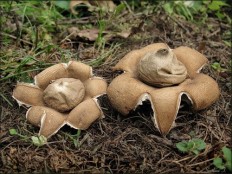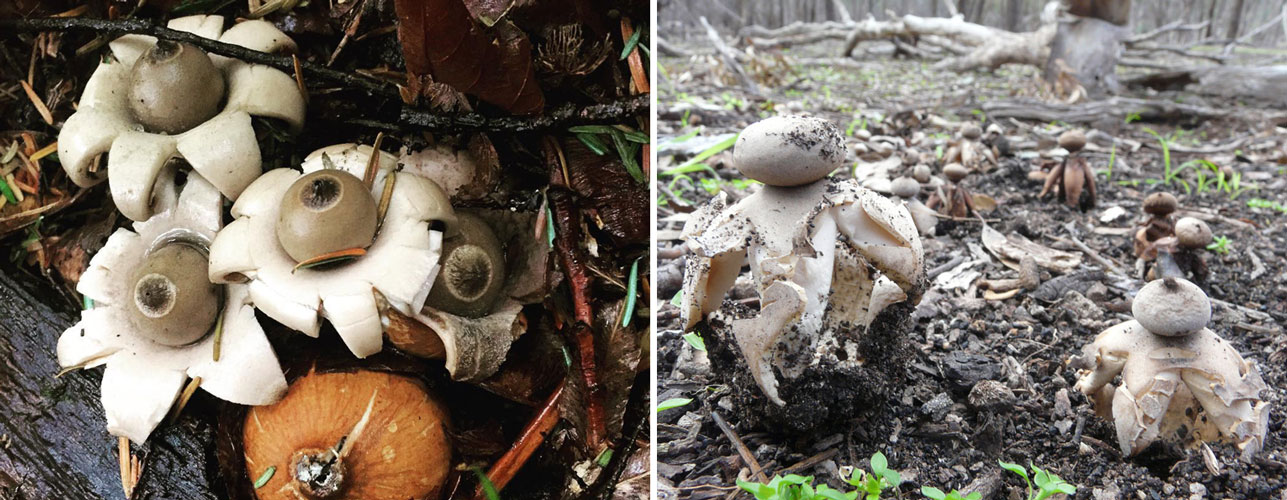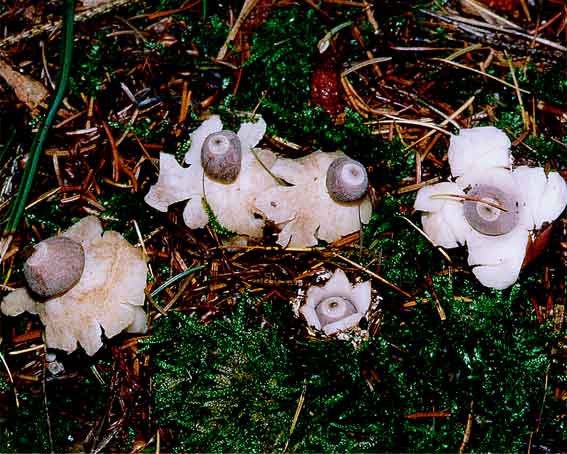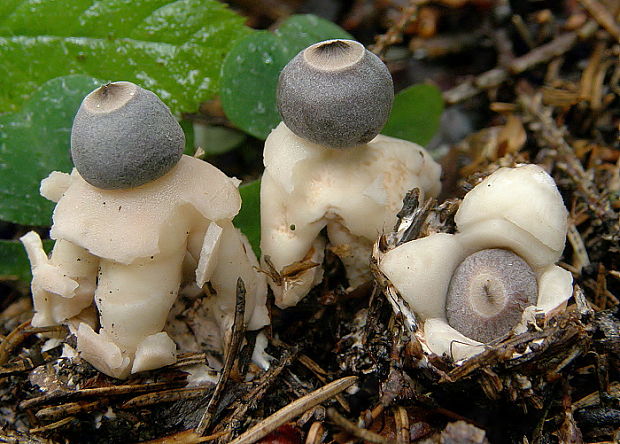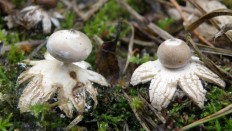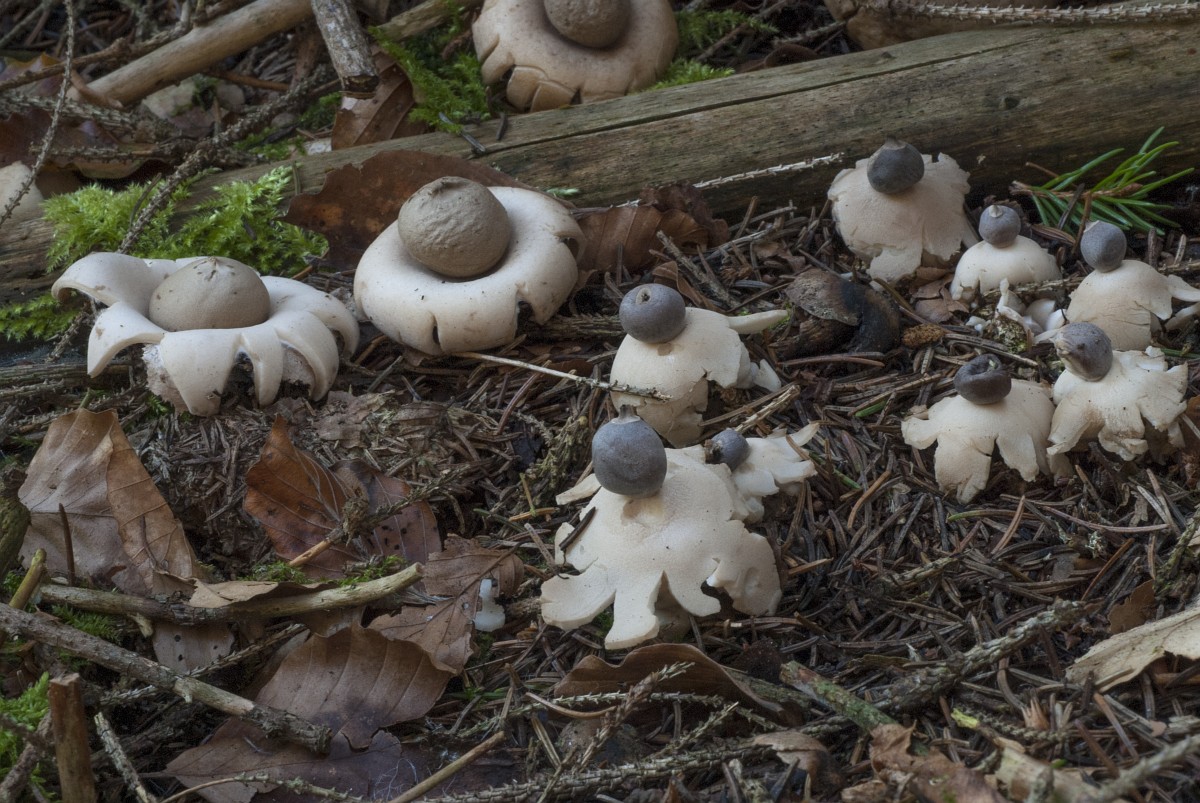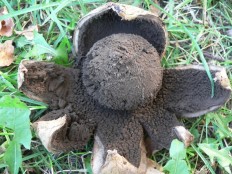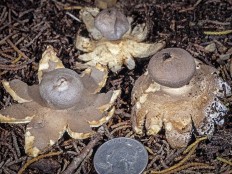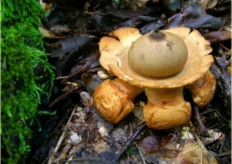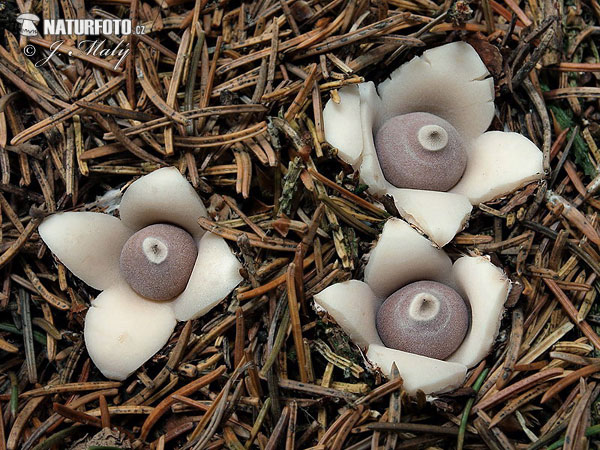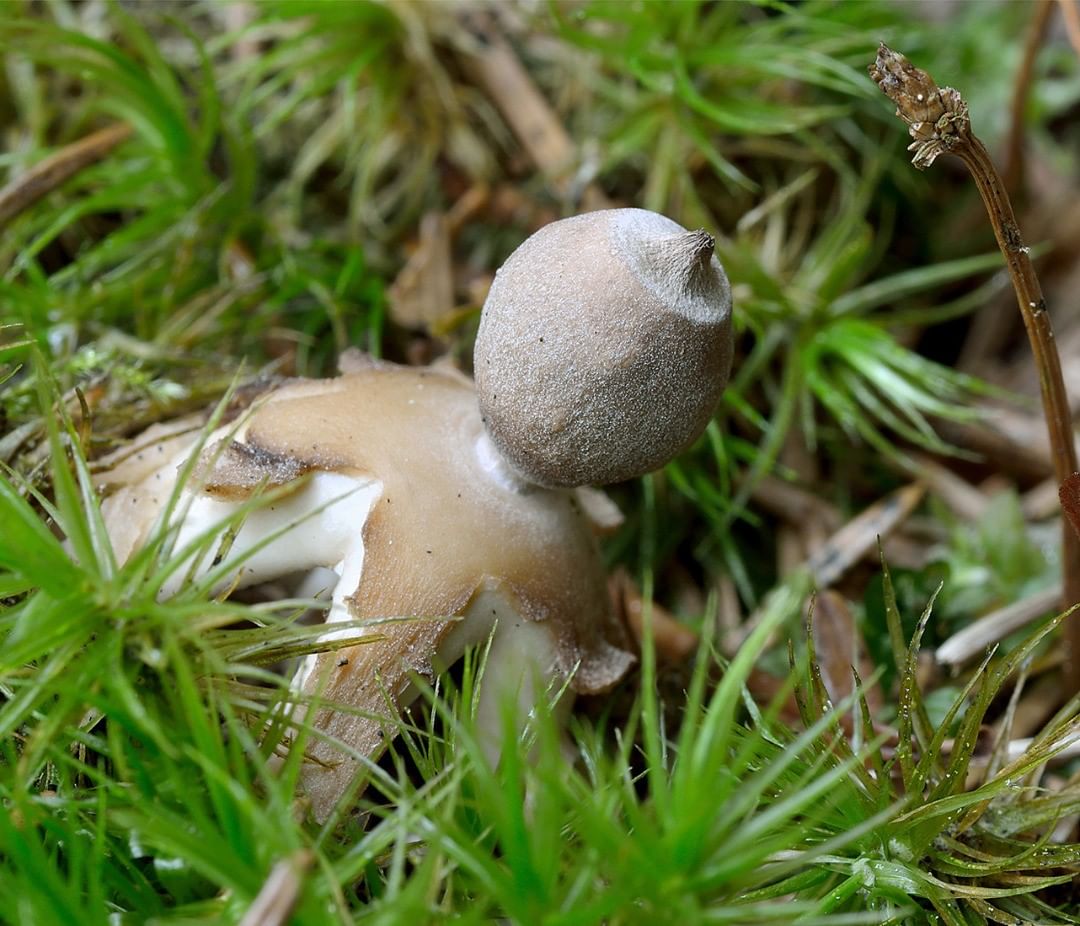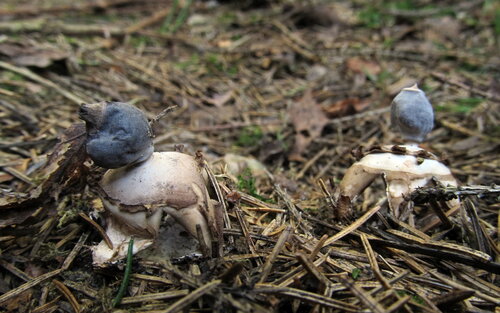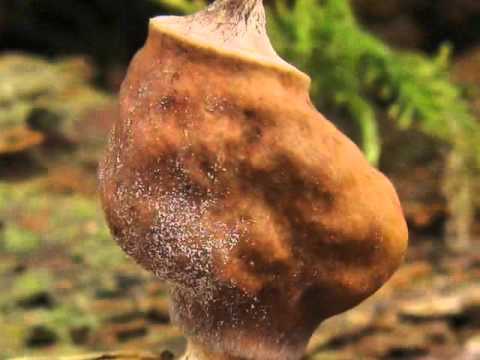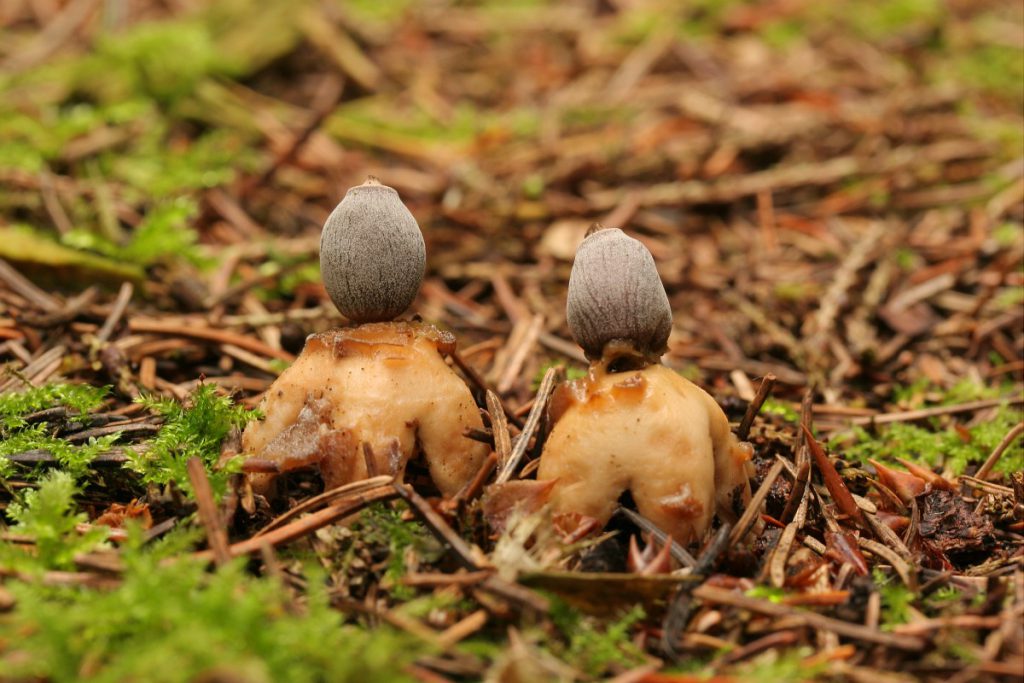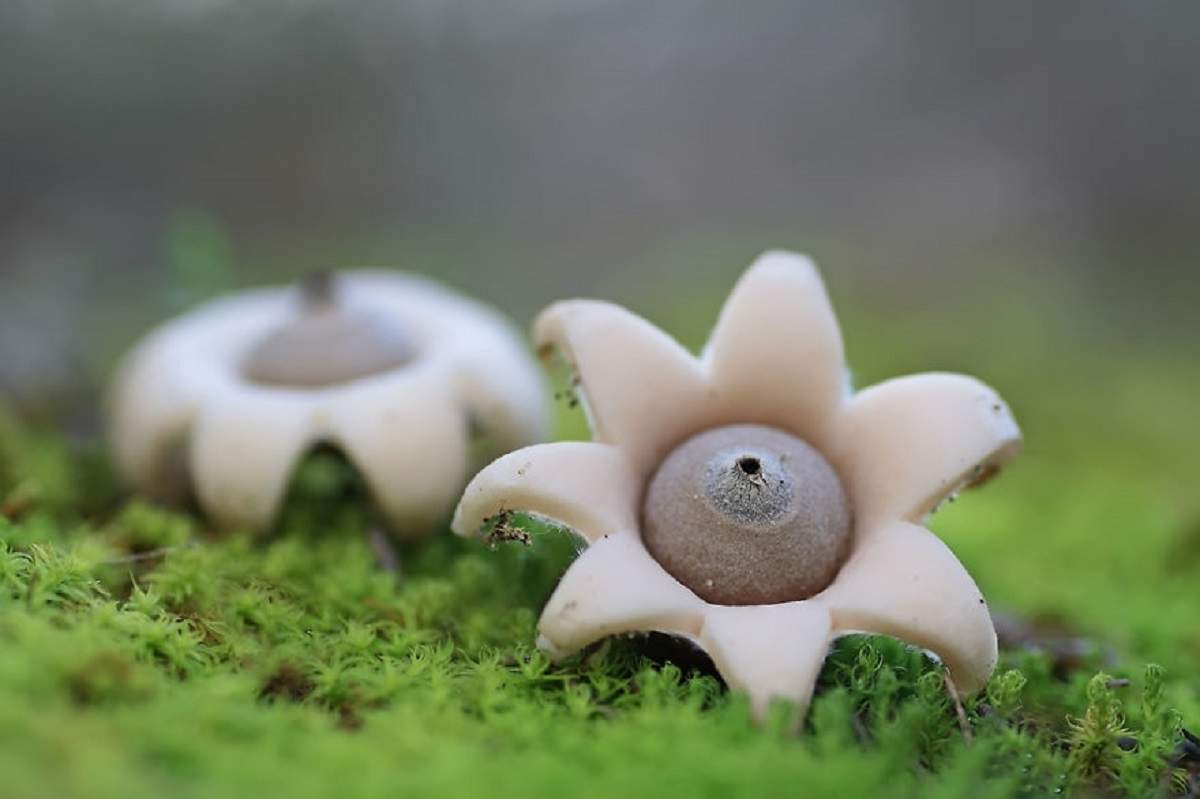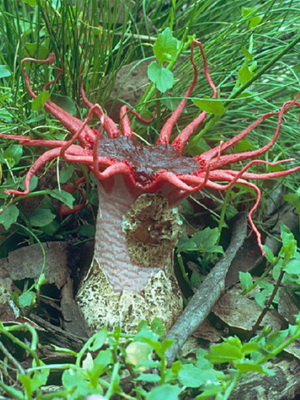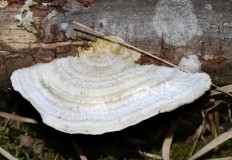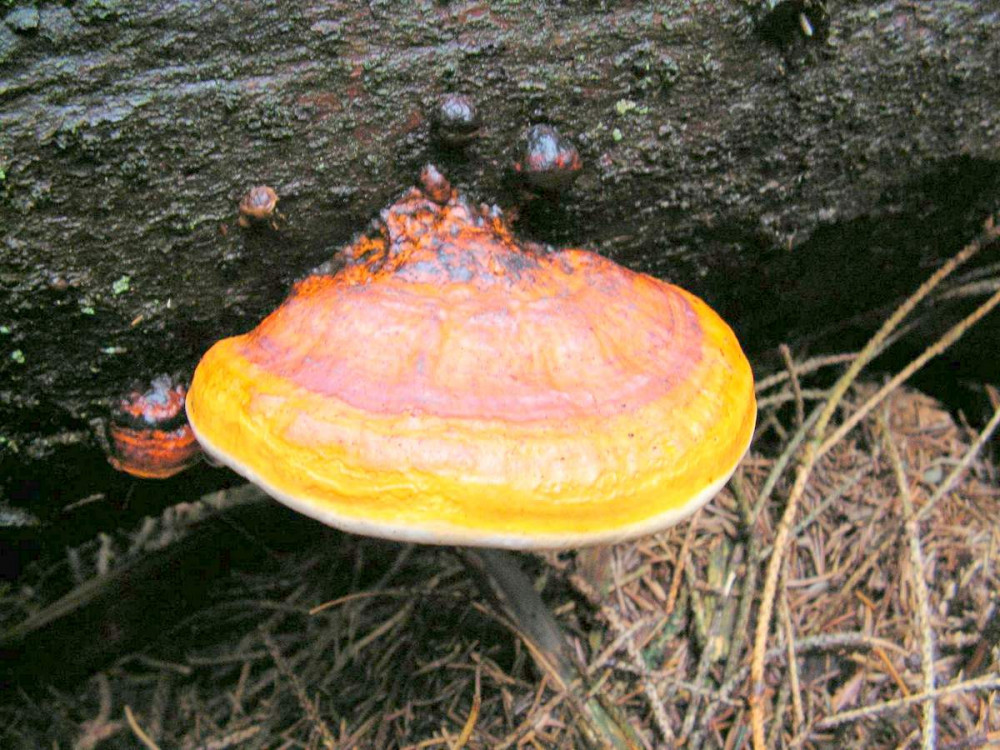Description
Young fruit bodies are underground, almost spherical or flattened, with ingrown litter particles. When the exoperidium opens, it breaks star-like into 4-5 (6) rays, 1-4 (6) cm in height. The rays are not hygroscopic, erect, with "arches" lifting the endoperidium above the ground, wide, with edges curved inward. When straightening exoperidia up to 9 cm in diameter. Mycelial layer of exoperidium with ingrowing litter particles, whitish on the inside, durable. The fibrous layer (between the inner mycelial layer) leathery to filmy, from the side of the endoperidium, first covered with a pseudoparenchymal layer, then exposed and white, from the side of the mycelial layer whitish, shiny, then becomes off-brownish white. The inner (pseudoparenchymal) layer (covering the exoperidium from the side hidden in young fruiting bodies, then showing) is at first whitish, then darkens to brownish or gray-brownish, occasionally pinkish, cracks with age.
The endoperidium surrounding the glebe is raised above the "star" on the leg-shaped process, spherical or flattened, about 0.7-1 cm in diameter. The pinnate is clearly defined, disc-shaped or conical.
Spores are generally dark brown, spherical, with a finely warty surface, 5.5–6.3 µm in diameter (including ornament). Capillary hyphae are thick-walled, 3-6 microns thick, with thin ends, yellowish-brown.
It has no nutritional value, it is considered an inedible mushroom.
Similar views edit code
- Geastrum leptospermum G. F. Atk. & Coker, 1903 - North American species, is even smaller, appears in winter and spring, grows on moss-covered stands of coniferous and deciduous trees.
- Geastrum minimum Schwein., 1822 - Small starfish - differs in a non-vaulted exoperidium with a large number of rays.
- Geastrum fornicatum (Huds.) Hook., 1821 - Vaulted starfish - is distinguished by the large size of the fruit bodies, more clearly limited by the peristome and smaller spores.
- Geastrum dissimile Bottomley, 1948 - African species, distinguished by a furrowed penistome.
- Geastrum welwitschii Mont., 1856 - is distinguished by ground young fruiting bodies, into the outer layer of which particles of litter do not grow, and also by a vaguely limited peristome.
Geastrum quadrifidum
- Other names for the mushroom:
- Starfire four-bladed
- Star wheel four-part
Synonyms:
- Star wheel four-part
- Geastrum four-bladed
- Earth star four-bladed
Description
Fruiting bodies are initially closed, spherical, about 2 cm in diameter, covered with a peridium, along the entire surface of which mycelial strands are located; mature - open, 3-5 cm in diameter. Peridium is four-layer, consists of exoperidium and endoperidium. Exoperidium in the form of a bowl, three-layer or two-layer, hard, breaks from top to bottom to the middle into 4 unequal, pointed parts (lobes), bending down, and fruiting bodies rise up on the lobes, as on "legs". The outer mycelial layer is whitish, felt, covered with soil particles, soon disappears. The middle fibrous layer is white or isabella, smooth. The inner fleshy layer is white, also torn into 4 parts, with sharp ends resting on the sharp ends of the blades of the outer layer, soon disappears. The base is convex. The middle rises up together with the inner part of the fruiting body - the gleba. The spherical or oval (ovoid) glebe is covered with endoperidium, 0.9-1.3 cm high and 0.7-1.2 cm wide. At the base with a flattened leg, above which the endoperidium is narrowed and a well-visible rounded protrusion (apophysis) is formed, at the apex it opens with an opening, which is equipped with a low peristome.The peristome is conical, fibrous, with a sharply limited courtyard, smoothly fibrous-ciliate, around which there is a clear ring. The stem is cylindrical or slightly flattened, 1.5-2 mm high and 3 mm thick, whitish. The column is cotton-wool, light brown-gray in section, 4-6 mm long. Its exoperidium ruptures more often by 4, less often by 4-8 unequal pointed lobes, bending downward, which is why the entire fruiting body rises up on the lobes, as on legs.
The leg (in the traditional sense) is missing.
Gleba is powdery when ripe, black-purple to brown. Spores are brownish, light or dark brown.
When pressed, the spores fly in all directions. Spores are olive brown.
HABITAT AND GROWTH TIME
Geastrum four-lobed grows mostly on sandy soil in deciduous, mixed and coniferous - pine, spruce, pine-spruce and spruce-deciduous forests (among fallen needles), sometimes in abandoned anthills - from August to October, rarely. Recorded in Russia (European part, Caucasus and Eastern Siberia), Europe and North America. We found it southeast of St. Petersburg in a mixed forest (birch and spruce) under an old spruce on needles in early October (the mushrooms grew as a family).
TWINS
Geastrum four-bladed is very peculiar in appearance and is strikingly different from mushrooms of other genera and families. It is similar to other starfish, for example, to the Vaulted starfish (Geastrum fornicatum), whose exoperidium splits into two layers: the outer one with 4-5 short, obtuse lobes and the inner, convex in the center, also with 4-5 lobes; on Zvezdovik crowned (Geastrum coronatum) with leathery, smooth exoperidium, splitting into 7-10 gray-brown pointed lobes; on Fringed Starfish (Geastrum fimbriatum) with exoperidium, which is torn by half or 2/3 - by 5-10 (less often up to 15) unequal blades; on Zvezdovik striped (G. striatum) with exoperidium, bursting into 6-9 lobes, and light gray gleb; on the small Starfish Shmiela (G. schmidelii) with exoperidium, forming 5-8 lobes, and a gleba with a beak-shaped grooved striped nose; on Zvezdovik triple (Geastrum triplex) with a fibrous hole at the top of a gray-brown block.
It is confined to the soils of deciduous and coniferous forests.
Varieties
The Zvezdovik family contains a number of edible and unsuitable for culinary purposes.
Edible
The vaulted starfish, or Geastrum fornicatum, is eaten.
The fruiting body is spherical. The shade is yellow-brown. Partially buried in soil. At the stage of maturity, it cracks into curling blades. The inner part is gray, at the stage of active fruiting it becomes chocolate.
Only young mushrooms are suitable for collection.
The pulp is light; as it grows, it coarsens and turns into a dark brown spore mass.
Suitable for use at a young age, as long as the mushroom retains its spherical appearance. It is used without preliminary heat treatment.
Conditionally edible
It has a low nutritional value, does not possess a pronounced smell and taste, a conditionally edible Schmidel variety, or Geastrum schmidelii.
The diameter of the fruiting body is up to 8 cm. The shape is initially round, in a mature mushroom it is stellate inherent in the family. The spore-bearing ball is crowned with a tapered tip.
Grows on desert soils and decayed wood residues in mixed forest areas. Fruiting in August.
Inedible
- Triple, or Geastrum triplex. The shape of young fruit bodies is rounded with a pointed tubercle, similar to a bulb. Height up to 5 cm, diameter up to 3.5 cm. In a mature mushroom, the body is revealed by a two-layer shell up to 12 cm wide. The shape of the inner center is in the form of a cupped collar under a flattened outer sessile shell. The color at the stage of full maturation is beige or terracotta. Spores are globular, brown in color. The structure of the outer pulp is compacted, leathery, the inner one is fragile and soft.Grows in deciduous and mixed forest belts. Grows in large groups of coniferous and leaf litter. Fruiting occurs at the end of summer and autumn.
- Striped, or Geastrum striatum. Young, bulbous fruiting bodies are located underground. As it matures, the mushroom shell bursts, dividing the mushroom into pointed blades and a head with a granular structure and a tapered striped tip. The color of an adult specimen is milky. The spores are brown. Grows on wilderness areas, decaying stumps and tree trunks in mixed forests, park areas. More often found under oak and ash trees. Fruiting from summer to autumn.
- Crowned, or Geastrum coronatum. The fruiting body is spherical. When cracked, it is divided into sharp-pointed gray blades with a matte sheen and a central spherical part of a brown tint. Spores are dark brown. Fruiting occurs in autumn. Occurs in gardens and park areas on sandy and clayey soils among grass.
- Fringed, or Geastrum fimbriatum. Initially, the shape of the fruiting body is spherical; at the stage of maturity, the three-layer dense shell breaks into a gray spore-bearing ball and yellow-brown star-like lobes, which twist when exiting the ground. Fruiting from the beginning of August. It grows on alkaline soils in coniferous and deciduous forests in large groups, often with witch's rings.
- Small, or Geastrum minimum. It differs from all in small size. The shape of the fruit body in young mushrooms is spherical. Diameter up to 1.8 cm, unfolded - up to 3.5 cm. Color gray with beige. The apex is crowned with a conical tubercle. The spores are brown. Grows on limestones in the steppe and forest edges.
- Black-headed, Geastrum melanocephalum. The shape of young mushrooms is spherical, pear-shaped or bulbous. Width up to 7 cm. Color from milky to brown. Star-shaped blades and a spore-bearing ball with a shaggy surface. Differs in complete exposure of the gleba when the inner shell is destroyed. The pulp is initially firm, becoming fibrous and powdery as it matures, the color is dark brown. Prefers humus soils. It grows in deciduous forest belts among maples and ash trees.
- Four-lobed, or Geastrum quadrifidum. The shape of the fruiting body is initially spherical, up to 2 cm in diameter, in adulthood - up to 5 cm. The peridium consists of 4 layers. The outer mycelium is whitish with a felt structure. Medium smooth, fibrous. Inner white, in a mature mushroom, it breaks into pointed lobes and a central part that is understood upwards. Gleb powdery color, black purple or brown. Grows on sandstones in pine, spruce and deciduous forests. Fruiting occurs in August-October.
Description of blackhead starfish
Young black-headed starfish have pear-shaped, spherical or bulbous fruiting bodies. The diameter of the fruiting body is 4-7 centimeters. The mushroom is pumped in with a sharp nose, the length of which reaches 2 centimeters. The color of the spout can be white or brown.
The outer shell of the fungus, called exoperidium, fuses with its inner shell, endoperidium. The main feature of the black-headed starlet is the destruction of endoperidium during the maturation of the fungus. As a result, the gleb is completely exposed.
The fungus can develop imperceptibly, and can partially protrude above the surface. When the shell disintegrates, 4-6 or 5-7 lobes are formed from it. There is information that there are specimens with 14 blades. These blades spread out on the ground or rise to a globular head.
The flesh of the black-headed starfish is at first dense, it consists of spores and capillaries (thin fibers). When the mushroom ripens, the pulp becomes slightly fibrous, powdery. The color of the pulp is dark brown. Capillation helps to loosen the spore mass. Capillaries are hygroscopic, they cause spores to move, causing them to spray.
Growing places of black-headed earthen stars
These mushrooms live in humus soils. You can find black-headed earthen stars in deciduous forests, gardens, forest parks. They prefer ash and maple plantations.
Black-headed starfish are not very common, even rare. They choose areas with warm climates. These mushrooms grow in European and Central Asian forests. For example, they are known in Switzerland, Austria, Hungary, Germany. In Russia, north of the Moscow region, these mushrooms are not found.
The number of black-headed starfish and measures for the protection of these mushrooms
This is a rare species. Black-headed starfish have a narrow range. Their habitats are destroyed under the influence of anthropogenic factors - people cut down forests, change the structure of the forest floor, and the like.
These mushrooms are protected in certain areas. To preserve the species, it is necessary to constantly monitor the population, search for new growth sites and observe the conservation regime.
The similarity of the black-headed starlet with other mushrooms
Due to the large size of this mushroom, the presence of a hairy ball and blades, the black-headed earthen star is difficult to confuse with other starfish.
Kindred of the blackhead star
Small starfish is an inedible mushroom. The development of fruiting bodies occurs underground, their shape is initially spherical, with a diameter of no more than 1.8 centimeters. The upper shell of the mushroom breaks into 6-12 rays, and the mushroom becomes like a star.
The color of the rays is silvery-beige. Small starfish grow on forest edges, clearings and in the steppes. They choose calcareous soils as a substrate.
The shape of the fruit bodies is at first spherical, over time the hard shell breaks and diverges to the sides, like a star. As the fruiting body emerges from the ground, individual rays are twisted. The inner part is spherical, without a leg, covered with a paper-thin shell. The pulp of this mushroom is tough, without a pronounced smell and taste.
Fringed starlets grow in groups or "witch rings". Fruiting occurs in autumn. They are mainly found on alkaline soil, under coniferous or deciduous trees.
Mushrooms Zvezdoviki
The most delicate soup with mushrooms New Year's tours to Holland in Delft Sports and tourism news. Statistics Online total: 1. Mushrooms in pictures. The fringed earthen star is a rare and unusual mushroom, although there are about thirty species of these mushrooms in our forests, earthen stars are the closest relatives of raincoats.

Young starfish, as they are also called, appear in the form of balls, when ripe, the part where the mushroom cap is usually located bursts into several petals, which are later tucked, and in the middle, there is a bag with spores, later, with final ripening, it also bursts and spores spill out.
Popular women's magazine about love. Views: Downloads: 0 Comments: 2 Rating: 4. Leave us your comment on the description of the mushroom
Your opinion is important to us
Four-bladed or four-bladed starfish, four-bladed Geastrum, four-bladed earth star, Geastrum quadrifidum are the names of one species of the Geastrov family. Does not represent nutritional value, belongs to inedible mushrooms. It is listed in the Red Data Book of the Tver and Voronezh regions as a rare species. At the beginning of development, the reproductive part is underground, the peridium is closed, rounded - up to 2 cm in diameter, the white surface is covered with micellar hyphae. In adulthood, the size of the fruiting body increases to 5 cm, the peridium, when it emerges from the soil, divides from four to seven pointed blades.
Edible mushrooms The group of edible mushrooms includes mushrooms that initially do not contain toxic and toxic compounds.Conditionally edible mushrooms The group of conditionally edible mushrooms includes mushrooms that contain substances that can harm the human body, or have a general bad taste.

Poisonous mushrooms. Inedible mushrooms In this group there are mushrooms that, due to their size, habitat, or high fibrous pulp, are not of culinary interest.
In color, the fruit body is gray with brown shades. The outer layer is rather fleshy, this is especially pronounced in the mushrooms that have not yet opened, the inner sac is a tone darker or lighter in color than the outer shell. The pulp of the mushroom is porous and cotton-like, light. Like raincoats, starfish are edible only until they ripen and as a result of the darkening of the pulp. Feels great in gloomy spruce thickets on alkali-rich soils.
It has no nutritional value. In biological reference books, the species is listed in the category of inedible mushrooms. The vaulted starfish belongs to the twins of the four-bladed geastrum.
Outwardly, mushrooms are very similar - the way, place and time of growth are the same for them. A double is determined by longer blades - up to 9 cm, at the beginning of growth, the peridium is yellow-brown in color and opens into two layers.
Mushroom application
The beneficial properties of the starfish have led to its use in medicine. Compounds in the tissues of the fruiting body help to stop blood and have an antiseptic effect, therefore, different medicines are made on the basis of this type.
Preparations based on the earthen asterisk are included in the complex of anticancer therapy.
In some cases, the opened petals after rupture of the membrane can be used as a plaster to stop blood and quickly heal small scratches and cuts.
Varieties
All representatives of the star family are divided into 2 large groups: conditionally edible and inedible. Vaulted eukaryotes belong to the first species, because in theory they can be used for food, although the pulp of the young geastrum is tasteless and odorless.
At the end of the life cycle, starfish are unsuitable for cooking any dishes, regardless of the species.
in nature, there are several varieties of geastrum, which are divided into conditionally edible and inedible
Similar species
Small starfish belongs to the inedible similar species. It grows in areas dominated by limestone. The speaking name indicates the small size of the cap during the period of underground development.
However, the shell of the fruiting body is divided into 10-12 parts. The four-bladed starlet has only 4 of them.
In addition, in this species, the upper surface of the endoperidium is smooth, and the vaulted specimens on the skin have microscopic fibers that resemble eyelashes.
A description of the starfish called striped says that this mushroom is small in size and light in color in the early stages of development. Its fruiting body resembles a bulb.
This species grows in soils with a high alkali content. For normal development, this starfish requires a lot of moisture, so you can find it in wetlands. The pulp can be eaten by pre-fried or boiled. Some mushroom pickers claim that when cooked, this mushroom tastes like champignons.
black-headed starfish belongs to the inedible species of geastrum
In warm forests, where mainly deciduous trees grow, in city parks and squares, you can find black-headed starfish. The dark color of the fruiting body, framed by a brown shell, is more reminiscent of a flower rather than a star, as in other similar species. The mushroom is inedible.
Starfire triple
- Family: Earth stars (Geastraceae).
- Synonyms: Earth star triple, earth star Indian.
Description. Starfish triple has a young fruit body, rounded, with a sharp nose, dirty brown color, up to 5 cm in height and 4 cm in diameter.Later, the outer layer breaks into 4-7 thick rays of isabella, terracotta or beige. When unfolded, the diameter of the fruiting body can reach 12 cm, and the height is 3-8 cm. The central part of the inner layer remains in the form of a characteristic collar under a spherical, sessile (without a leg) pale brown spore-receptacle. At the top of the latter, during maturation, a hole appears for the exit of spores. The pulp of the outer layer is soft, fragile, juicy; its outer layer is more dense, elastic, leathery. The spore mass, when ripe, is powdery, olive-brown.
The triple star fungus grows in deciduous and mixed forests, among fallen leaves and needles, often found in parks, squares, gardens. Recorded in the European part of Russia, southern Siberia, Primorsky Krai. Fruiting from August to late October.
Interesting Facts. Among the Blackfoot tribe (Indians of North America), the mushroom was called "ka-ka-toos", which meant "falling star" and, according to legend, the discovery of such mushrooms foreshadowed some supernatural events.
Similar species. In an adult state, the characteristic three-component structure of the fruiting body does not allow the triple starlet mushroom to be confused with any other earthen star.
Pharmacological and medical properties. A number of biologically active substances have been isolated from the fruit bodies of Geastrum triplex. Among them, mention should be made of fungal sterols such as ergosta-4,6,8, (14), 22-tetraene-3-ene, 5,6-dihydroergosterol, ergosterol and peroxyergosterol. Mushrooms also contain various fatty acids (myristic, palminic, stearic, oleic, α-linoleic, linoleic, etc.) that can be used for medicinal purposes.
Traditional and folk medicine. The triple earthen star was used for medical purposes by the Indians of North America. The Cherokee, for example, used the mushroom to heal the navel of newborns to the point of drying out and falling off the umbilical cord, both for prophylactic and therapeutic purposes.
In traditional Chinese medicine, G. triplex has been used to relieve redness (inflammation) in the airways, as well as to stop bleeding and shrink tumors.
Culinary recommendations. It is edible at a very young age, but at this moment it is quite difficult to find it, since the mushroom is almost completely submerged in the soil.
Geastrum quadrifidum
- Other names for the mushroom:
- Starfire four-bladed
- Geastrum four-bladed
Synonyms:
- Star wheel four-part
- Geastrum four-bladed
- Earth star four-bladed
Description
Fruiting bodies are initially closed, spherical, about 2 cm in diameter, covered with a peridium, along the entire surface of which mycelial strands are located; mature - open, 3-5 cm in diameter. Peridium is four-layer, consists of exoperidium and endoperidium. Exoperidium in the form of a bowl, three-layer or two-layer, hard, breaks from top to bottom to the middle into 4 unequal, pointed parts (lobes), bending down, and fruiting bodies rise up on the lobes, as on "legs". The outer mycelial layer is whitish, felt, covered with soil particles, soon disappears. The middle fibrous layer is white or isabella, smooth. The inner fleshy layer is white, also torn into 4 parts, with sharp ends resting on the sharp ends of the blades of the outer layer, soon disappears. The base is convex. The middle rises up together with the inner part of the fruiting body - the gleba. The spherical or oval (ovoid) glebe is covered with endoperidium, 0.9-1.3 cm high and 0.7-1.2 cm wide. At the base with a flattened leg, above which the endoperidium is narrowed and a well-visible rounded protrusion (apophysis) is formed, at the apex it opens with an opening, which is equipped with a low peristome. The peristome is conical, fibrous, with a sharply limited courtyard, smoothly fibrous-ciliate, around which there is a clear ring. The stem is cylindrical or slightly flattened, 1.5-2 mm high and 3 mm thick, whitish.The column is cotton-wool, light brown-gray in section, 4-6 mm long. Its exoperidium ruptures more often by 4, less often by 4-8 unequal pointed lobes, bending downward, which is why the entire fruiting body rises up on the lobes, as on legs.
The leg (in the traditional sense) is missing.
Gleba is powdery when ripe, black-purple to brown. Spores are brownish, light or dark brown.
When pressed, the spores fly in all directions. Spores are olive brown.
HABITAT AND GROWTH TIME
The four-part starfish grows mostly on sandy soil in deciduous, mixed and coniferous - pine, spruce, pine-spruce and spruce-deciduous forests (among fallen needles), sometimes in abandoned anthills - from August to October, rarely. Recorded in Russia (European part, Caucasus and Eastern Siberia), Europe and North America. We found it southeast of St. Petersburg in a mixed forest (birch and spruce) under an old spruce on needles in early October (the mushrooms grew as a family).
TWINS
The four-part starfish is very peculiar in appearance and is strikingly different from mushrooms of other genera and families. It is similar to other starfish, for example, to the Vaulted starfish (Geastrum fornicatum), whose exoperidium splits into two layers: the outer one with 4-5 short, obtuse lobes and the inner, convex in the center, also with 4-5 lobes; on Zvezdovik crowned (Geastrum coronatum) with leathery, smooth exoperidium, splitting into 7-10 gray-brown pointed lobes; on Fringed Starfish (Geastrum fimbriatum) with exoperidium, which is torn by half or 2/3 - by 5-10 (less often up to 15) unequal blades; on Zvezdovik striped (G. striatum) with exoperidium, bursting into 6-9 lobes, and light gray gleb; on the small Starfish Shmiela (G. schmidelii) with exoperidium, forming 5-8 lobes, and a gleba with a beak-shaped grooved striped nose; on Zvezdovik triple (Geastrum triplex) with a fibrous hole at the top of a gray-brown block.
It is confined to the soils of deciduous and coniferous forests.





